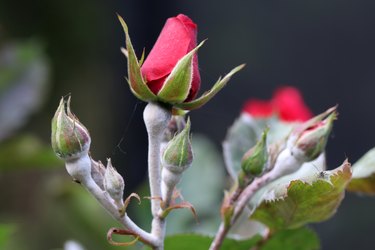
There's no one best fungicide for plants, simply because so many different kinds of plants are cultivated and they're susceptible to infection from so many kinds of fungus. A good rule of thumb for home gardeners is to opt for the least-toxic fungicide that will still get the job done, which often means turning to household ingredients. One example is vinegar, which can be an effective weapon against powdery mildew and other fungi if you intervene before it becomes widespread.
What Is Powdery Mildew?
Video of the Day
Powdery mildew is the most common form of white fungus you'll find in your garden or indoor potted plants. It's not one fungus but a large family of related fungi, each affecting a different type of plant (Podosphaera xanthii, for example, is often the one that infests your zucchinis and cucumbers). The good news is that the mildew on your roses won't infect your vegetables, and vice versa. The bad news is that there are varieties of the fungus corresponding to many common plants, including — aside from roses and cucurbits — ornamentals such as azaleas, phlox, lilac, dahlia, and zinnias, edibles including beans, berries, and tomatoes, and (where cultivation is legal) cannabis.
Video of the Day
A similar pathogen is downy mildew, which has a like appearance but can only be seen on the bottom of your leaves, while powdery mildew can be found on the top and bottom of the leaves. If you catch the mildew before it can become established, a vinegar solution can successfully keep it from spreading.
Powdery Mildew and Vinegar
Vinegar and other home remedies work by altering pH at the surface of the plants' leaves. Every living organism has its "comfort zone" of ideal conditions, and fungi are no different. Misting the plants heavily with a solution of diluted vinegar lowers the pH past the zone where spores can reproduce freely, stopping their spread.
The time to apply a vinegar solution, or other home remedies, is when you see the first small patches of fungus on the leaves. Start by wiping the leaves clean with a damp cloth, to physically remove as much of the mold as possible. Then spray the leaves and stems of the affected plants thoroughly, top and bottom. The best time to do this is early in the morning on a sunny day, so the leaves have plenty of time to dry before nightfall.
Getting the Ratio Right
A crucial detail is how much vinegar to use in your spray. It's confusing, because as you research the right ratio, you'll see experienced gardeners suggesting as little as 1 or 2 teaspoons of vinegar per gallon of water, to as much as 3 to 4 tablespoons. In practice any of those ratios can work, but it's a balancing act: Too little may not adequately control the mildew; too much may damage your plants. Some plants are more susceptible to acidity than others, as are some strains of mildew.
A good practice is to start with a relatively low concentration, such as 1 tablespoon of vinegar per gallon, and observe its effect. If you experience good control of the mildew and your plants seem healthy, continue at that ratio. If your plants show stress after being misted, reduce the amount of vinegar. If your plants tolerate it well, gradually increase the quantity of vinegar until you achieve good control over the mildew. Once you've begun, it's best to continue spraying throughout the season, as a preventive measure.
Tip
Both household white vinegar and apple cider vinegar are widely used and recommended for fungus control, and work about equally well. Use a vinegar that's 5 percent acetic acid by volume. Do not use horticultural vinegar, which is 20 percent acetic acid by volume.
Other Control Options
It's important to remember that a given strain of mildew may respond better to one treatment than another. If you've tried a white vinegar fungicide or apple cider vinegar for plant fungus, and experienced poor or middling results, there's no harm in trying something else. A baking soda spray made with a tablespoon of baking soda and a gallon of water (with equal parts vegetable oil and dish soap, to help it stick to the leaves) works much the same way, except it raises, rather than lowers, the pH.
Another non-toxic option that some gardeners recommend is milk, diluted with water. A ratio of at least 3 parts water to 1 part milk, or up to 10 parts water, will work. A more-dilute solution is best for indoor plants, where the smell of soured milk would be obvious after a few days.
Good cultural practices will also help a lot. Keeping your plants at the recommended spacings, and thinning them to allow good air circulation, will help provide an inhospitable environment for fungi. Water in the morning, so plants can dry overnight. When possible, remove the affected leaves at the first sign of mildew and dispose of them in the trash, not your compost. If mildew is a recurring problem in your location with one kind of plant in particular (again, roses and cucurbits are common examples), you can save yourself aggravation by ordering and planting mildew-resistant cultivars.